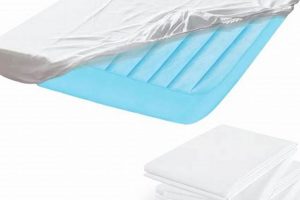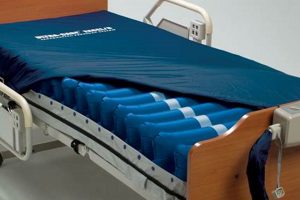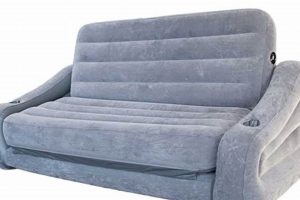Addressing deflation issues in inflatable sleeping surfaces often involves locating and sealing punctures or leaks. This process typically requires identifying the source of the escaping air, preparing the surrounding area, and applying an appropriate sealant or patch to restore air retention.
Maintaining a functional inflatable sleeping surface provides a comfortable and convenient solution for temporary bedding needs. The ability to repair damage extends the lifespan of the product, offering economic and environmental benefits by reducing the need for replacement. Historically, patching and repair techniques have evolved from simple adhesives to more advanced materials and methods, increasing the success rate of such interventions.
The following sections will detail common methods for locating leaks, preparing the surface for repair, and applying effective patching techniques. Specific tools and materials, along with preventative measures, will also be discussed to ensure optimal results and prolong the life of the inflatable sleeping surface.
Repair Strategies for Inflatable Sleeping Surfaces
The following strategies offer guidance on effectively addressing common issues that lead to air loss in inflatable sleeping surfaces. Employing these techniques can significantly extend the life and usability of such products.
Tip 1: Leak Detection Through Auditory Inspection: Carefully listen for hissing sounds emanating from the inflated surface. This method is most effective in a quiet environment and can help pinpoint larger leaks.
Tip 2: Soap and Water Solution for Leak Localization: Apply a mixture of soap and water to the surface. Bubbles forming at a specific location indicate the presence of an air leak. Mark the area for subsequent repair.
Tip 3: Proper Surface Preparation Prior to Patching: Thoroughly clean and dry the area surrounding the leak. This ensures proper adhesion of the patch and prevents future detachment. Isopropyl alcohol can be used for effective cleaning.
Tip 4: Use of Appropriate Patching Materials: Select a patch material that is compatible with the surface material of the inflatable sleeping surface. Vinyl repair kits are generally suitable for vinyl surfaces, while specialized adhesives may be required for other materials.
Tip 5: Application of Even Pressure During Patching: When applying the patch, ensure even pressure is applied across its entire surface. This promotes a strong bond and prevents air from escaping at the edges.
Tip 6: Allow Adequate Curing Time for Adhesive: Adhere to the adhesive manufacturer’s recommended curing time before re-inflating the surface. Premature inflation can compromise the bond and lead to patch failure.
Tip 7: Reinforcement of Weakened Seams: For leaks occurring at seams, consider using a flexible sealant designed for inflatable products. Apply the sealant along the entire seam length to prevent further air loss.
Implementing these techniques enhances the success rate of inflatable sleeping surface repairs, minimizing the need for costly replacements and promoting product longevity.
The following sections will address preventative measures and proper storage techniques to further extend the lifespan of inflatable sleeping surfaces.
1. Locate the leak
The ability to rectify issues related to inflatable sleeping surfaces is contingent upon accurate leak identification. The procedure for effecting a solution requires, as a primary step, the determination of the precise location from which air is escaping. Without a clear pinpointing of this area, any subsequent attempts to seal or patch the surface are likely to be ineffectual.
Consider a scenario where an inflatable sleeping surface rapidly deflates during use. Superficial inspection may not reveal the source of air loss. However, employing methods such as auditory analysis (listening for hissing sounds) or the application of soapy water to the surface (observing for bubble formation) can reveal the exact site of a puncture or seam failure. This targeted approach contrasts with randomly applying patches across the surface, which is wasteful and generally unsuccessful.
In summary, the process of fixing an inflatable sleeping surface commences with and is governed by the meticulous location of the air leak. This critical step dictates the subsequent repair strategy and ultimately determines the success of restoring the inflatable to its functional state. Failure to accurately identify the leak renders all further remediation efforts futile, underscoring the fundamental importance of this initial stage.
2. Surface preparation
Surface preparation is a critical determinant in the efficacy of any repair performed on an inflatable sleeping surface. Inadequate preparation compromises the adhesion of patching materials, directly impacting the longevity and reliability of the repair. The presence of dirt, oils, or moisture on the surface creates a barrier, preventing the sealant or patch from forming a secure bond. This, in turn, leads to premature failure of the repair and continued air leakage. A practical example illustrates this point: an inflatable mattress punctured during camping requires immediate repair. If the repair area is not properly cleaned of dirt and debris accumulated during use, the applied patch will likely peel away, rendering the repair ineffective.
The specific method of surface preparation varies based on the material composition of the inflatable sleeping surface. For vinyl surfaces, cleaning with isopropyl alcohol followed by thorough drying is typically recommended. This removes residues and ensures optimal adhesion. For fabric-covered surfaces, gentle abrasion with fine-grit sandpaper may be necessary to create a textured surface, enhancing the patch’s grip. Skipping this step significantly reduces the likelihood of a successful, long-term repair. Furthermore, environmental conditions such as humidity can affect the drying process, emphasizing the need for careful attention to detail during preparation.
In conclusion, surface preparation constitutes an indispensable component of any strategy aimed at repairing inflatable sleeping surfaces. Proper cleaning, degreasing, and drying of the repair area directly correlate with the strength and durability of the resulting bond. This meticulous attention to detail, while seemingly minor, significantly impacts the overall success of the repair, ultimately prolonging the lifespan and usability of the inflatable sleeping surface. Failure to prioritize this step undermines the entire repair process, leading to recurring air leaks and potentially rendering the inflatable unusable.
3. Appropriate patching materials
The selection of appropriate patching materials is paramount to the successful repair of inflatable sleeping surfaces. Compatibility between the patching material and the air mattress material is a key factor in ensuring a durable and airtight seal. The use of unsuitable materials can lead to patch failure, rendering the repair ineffective.
- Material Compatibility
The patching material must be chemically and physically compatible with the air mattress. Vinyl mattresses require vinyl patches, while flocked surfaces necessitate patches designed to adhere to textured surfaces. Mismatched materials result in weak adhesion and subsequent air leakage. For example, applying a standard vinyl patch to a flocked surface will likely fail due to the lack of a strong bond with the fibers.
- Adhesive Properties
The adhesive used with the patch is equally critical. Adhesives must form a strong, waterproof bond with both the patch and the mattress material. Specialized adhesives are often required for certain materials, such as thermoplastic polyurethane (TPU). General-purpose adhesives may not provide adequate adhesion or may damage the air mattress material. Incorrect adhesive usage results in incomplete sealing of the damaged area.
- Patch Size and Shape
The patch should be adequately sized to cover the damaged area with sufficient overlap. The shape should be appropriate to the tear or puncture, with rounded corners to minimize stress concentration that could lead to peeling. Using a patch that is too small or irregularly shaped increases the risk of air leakage around the patch edges. An over-sized patch, however, may cause inflexibility to the mattress, resulting in damage to the patch and mattress when folded for storage.
- Durability and Flexibility
The patching material must be both durable and flexible to withstand the stresses of inflation, deflation, and use. Rigid patches can crack or detach under pressure, while flimsy patches may stretch or tear. A durable, flexible patch provides a long-lasting repair that maintains airtightness throughout the air mattress’s lifespan. High-quality patches resist wear and tear from folding and storing the mattress.
In summary, the selection of appropriate patching materials involves careful consideration of material compatibility, adhesive properties, patch size and shape, and durability and flexibility. The proper choice and application of these materials ensures a long-lasting repair and prevents recurring air leakage, thereby extending the lifespan of the inflatable sleeping surface.
4. Adhesive Application
Adhesive application is a pivotal stage in the repair of inflatable sleeping surfaces, directly influencing the integrity and longevity of the seal. The method and precision of this process determine the overall success of mitigating air leakage and restoring the functionality of the mattress.
- Surface Coverage and Consistency
Uniform adhesive distribution across both the patch and the prepared surface of the inflatable sleeping surface is essential. Insufficient adhesive results in weak bonding, while excessive adhesive can cause seepage and hinder proper curing. A thin, even layer ensures maximum contact area and optimal adhesion. Inadequate distribution leads to air pockets and potential leak paths.
- Adhesive Type and Compatibility
Employing an adhesive compatible with both the patch material and the inflatable sleeping surface material is critical. Vinyl adhesives are generally suitable for vinyl mattresses, while specialized adhesives exist for rubberized or fabric-coated surfaces. Incompatible adhesives may dissolve the surface material or fail to create a durable bond, resulting in premature failure of the repair. Some adhesives require activation with heat or UV light to cure effectively.
- Application Technique and Pressure
The application technique impacts the strength of the bond. Applying pressure evenly across the patch surface after adhesive application facilitates optimal contact and minimizes air pockets. Rolling the patch with a hand roller or applying consistent pressure for a sustained period ensures maximum adhesion. Inconsistent pressure results in uneven bonding and potential weak spots in the seal.
- Drying and Curing Time
Adhering to the adhesive manufacturer’s recommended drying and curing times is essential for achieving a durable seal. Premature inflation before the adhesive is fully cured compromises the bond strength and may lead to patch detachment. Environmental factors, such as temperature and humidity, can also affect drying times, requiring adjustments to the curing process. Allowing adequate time guarantees a complete and robust bond.
These facets of adhesive application are interconnected and cumulatively determine the effectiveness of repairing inflatable sleeping surfaces. A comprehensive understanding and meticulous execution of each aspect are necessary to achieve a lasting and airtight seal, thereby extending the usable life of the inflatable mattress and preventing recurring air leaks. Correct application ensures the effort and materials invested yield a functional and reliable outcome.
5. Curing time
The adherence to specified curing times constitutes a critical factor in achieving durable and effective repairs of inflatable sleeping surfaces. This temporal element directly influences the strength and longevity of the adhesive bond between the patch and the mattress material, ultimately determining the success of the repair.
- Adhesive Polymerization
Curing time allows for the complete polymerization of the adhesive compounds. Polymerization is the chemical process by which the adhesive molecules cross-link to form a solid, durable bond. Insufficient curing time results in incomplete polymerization, leaving the adhesive weak and susceptible to premature failure. For instance, if an adhesive requires 24 hours to fully cure but the mattress is inflated after only 12 hours, the patch will likely detach under pressure.
- Environmental Factors
Environmental conditions, such as temperature and humidity, can significantly affect curing times. High humidity can slow down the evaporation of solvents in the adhesive, prolonging the necessary curing time. Conversely, high temperatures can accelerate the curing process. Therefore, it is imperative to adhere to manufacturer-specified curing times, adjusted as necessary for the prevailing environmental conditions. Ignoring environmental factors can lead to an improperly cured bond, reducing repair effectiveness.
- Stress Application and Bond Strength
Premature stress application, such as inflating the mattress before the adhesive is fully cured, weakens the bond and compromises the overall repair. The curing process requires time for the adhesive to develop its maximum strength and elasticity. Applying stress before this point can disrupt the bonding process, leading to air leaks or patch detachment. Delaying inflation until the recommended curing time has elapsed is essential for achieving a robust and reliable seal.
-
Adhesive Type Variations
Different adhesives have varying curing time requirements, depending on their chemical composition. Some adhesives, like cyanoacrylates (instant glues), cure rapidly, while others, such as epoxies, require extended curing times. Using an adhesive with an inappropriate curing profile for the material or application can lead to a weak or brittle bond, rendering the repair ineffective. Adhering to the specific curing instructions for the chosen adhesive is crucial for achieving a durable and airtight seal.
In conclusion, the consideration of curing time constitutes an integral part of any repair strategy aimed at fixing inflatable sleeping surfaces. Understanding the underlying chemical processes, environmental influences, stress application, and adhesive type variations directly impacts the success of the repair. Adhering to recommended curing times, adjusted for environmental factors and adhesive properties, ensures a robust and lasting seal, preventing premature failure and extending the lifespan of the inflatable mattress.
Frequently Asked Questions
This section addresses common inquiries related to the repair of inflatable sleeping surfaces, providing clear and concise answers to ensure effective and lasting results.
Question 1: What is the most effective method for locating a leak in an inflatable sleeping surface?
The most effective method involves inflating the mattress and carefully listening for hissing sounds, particularly in a quiet environment. Alternatively, a solution of soapy water can be applied to the surface; bubble formation indicates the location of the leak.
Question 2: Is it necessary to deflate the mattress completely before attempting a repair?
Yes, complete deflation is generally required. This allows for proper surface preparation and ensures that the patch adheres effectively to the deflated material, preventing air pockets and promoting a secure bond.
Question 3: What type of adhesive is recommended for patching vinyl inflatable mattresses?
A vinyl-specific adhesive is recommended. These adhesives are formulated to create a strong, waterproof bond with vinyl materials, ensuring a durable and long-lasting repair. General-purpose adhesives may not provide adequate adhesion.
Question 4: How long should the adhesive cure before re-inflating the mattress?
The adhesive manufacturer’s instructions should be followed precisely. Generally, a curing time of 24 hours is recommended to ensure that the adhesive fully sets and creates a robust bond. Premature inflation can compromise the repair.
Question 5: Can leaks located on seams be effectively repaired?
Repairing leaks on seams can be challenging but is possible. A flexible sealant specifically designed for inflatable products is often recommended for this purpose. Multiple applications may be necessary to ensure a complete seal.
Question 6: Are there any preventative measures that can be taken to minimize the risk of punctures and leaks?
Yes, several measures can be taken. These include using a protective layer between the mattress and the floor, avoiding sharp objects near the mattress, and storing the mattress properly when not in use. Maintaining appropriate inflation levels can also reduce stress on the material.
In summary, successful inflatable sleeping surface repair hinges on accurate leak detection, proper surface preparation, the use of compatible materials, and adherence to recommended curing times. Implementing preventative measures can further extend the lifespan of the product.
The following section will discuss preventative measures and proper storage techniques to further extend the lifespan of inflatable sleeping surfaces.
Conclusion
The process described as “how do you fix an air mattress” encompasses a series of precise steps, from accurate leak detection and meticulous surface preparation to the selection of compatible patching materials and adherence to recommended curing times. Each stage is crucial for achieving a durable and lasting repair, ensuring the continued functionality of the inflatable sleeping surface.
Effective execution of these repair techniques not only extends the lifespan of the product but also contributes to resource conservation by minimizing the need for replacements. Proper adherence to established methods enhances the probability of a successful repair, reinforcing the importance of a systematic and informed approach when addressing damage to inflatable sleeping surfaces.







